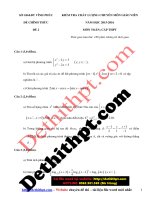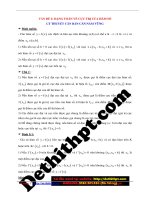Đề 2 image marked image marked
Bạn đang xem bản rút gọn của tài liệu. Xem và tải ngay bản đầy đủ của tài liệu tại đây (1.71 MB, 7 trang )
Exercise 2:
Read the following passage and mark the letter A, B, C or D to indicate the correct answer to each
of the questions.
PANDEMIC DISEASES
Diseases are a natural part of life on earth. If there were no diseases, the population would grow too
quickly, and there would not be enough food or other resources, so in a way, diseases are natural ways of
keeping the Earth in balance. But sometimes they spread very quickly and kill large numbers of people.
For example, in 1918, an outbreak of the flu across the world, killing over 25 million people only in six
months. Such terrible outbreaks of a diseases are called pandemics.
Đăng ký file Word tại link sau
/>
Pandemics happen when a disease changes in a way that our bodies are not prepared to fiht. In 1918,
a new type of fl virus appeared. Our bodies had no way to fiht this new flu virus, and so it spread very
quickly and killed large numbers of people. While there have been many different pandemic diseases
throughout history, all of them have a new thing in common. First, all pandemic diseases spread from one
person to another very easily.
Second, while they may kill many people, they generally do not kill people very quickly. A good
example of this would be the Marburg virus. The Marburg virus is an extremely infectious disease. In
addition, it is deadly. About 70%-80% of all people who get the Marburg virus died from the disease.
However, the Marburg virus has not become a pandemics because most people die within three days of
getting the disease. This means that the virus does not have enough time to spread a large number of
people. The flu virus of 1918, on the other hand, generally took about a week to ten days to kill its
victims, so it had more time to spread.
While we may never be able to completely stop pandemics, we can make them less common. Doctors
carefully monitor new disease that they fear could become pandemics. For example, in 2002, and 2003,
Trang 1
doctors carefully watched SARS. Their health warming may have prevented SARS from becoming a
pandemic.
QUESTION
Question 1. This passage is mainly about _____.
A. How to prevent pandemic diseases
B. Pandemic diseases
C. Pandemic diseases throughout history
D. Why pandemics happen
Question 2. According to paragraph 1, how are diseases a natural part of life on Earth?
A. They prevent pandemics
B. The help control the population
C. They led the world grow quickly
D. They kill too many people
Question 3. Based on the information in the passage the term "pandemics" can be explained as______.
A. Diseases with no cure
B. A deadly kind of flu
C. Diseases that spread quickly and kill large number of people
D. New disease like SARS or the Marburg virus
Question 4. According to the passage, what cause pandemics?
A. changes in a diseases that the body cannot fight
B. careless doctors who do not watch the spread of diseases
C. population growth that the world cannot support
D. the failure to make new medicines.
Question 5. According to the passage, all of the following are true of the 1918 flu pandemic EXCEPT
that ___________.
A. It involved a new kind of flu virus
B. It involved a new kind of flu virus
C. It was the last pandemic in history
D. It took a little over a week to kill its victims
Question 6. The word "it" in the passage refers to ________.
A. disease
B. flu virus
C. pandemics
D. bodies
Question 7. Which of the following is mentioned as a common feature of all pandemic diseases?
A. They spread from people to people very quickly
B. It kill many people very quickly
C. They do not kill people very quickly
D. They kill all the victims
Question 8. According to paragraph 3, why hasn't Marburg virus become a pandemic?
Trang 2
A. It is not a deadly diseases
B. It does not spread from person to person easily
C. Doctors have prevented it from becoming a pandemic
D. It kills people too quickly
Question 9. The word "monitor" in the passage is closest in meaning to ________
A. prevent
B. fight
C. watch
D. avoid
Question 10. The author mention SARS in order to _____.
A. Give an example of a highly dangerous disease
B. Suggest that SARS will never become a pandemic
C. Give an example of the successful prevention of a pandemic
D. Suggest that there may be a new pandemic soon
GIẢI CHI TIẾT
Question 1: This passage is mainly about ___.
A. how to prevent pandemic diseases
B. pandemic diseases
C. pandemic diseases throughout history
D. why pandemics happen
Dịch nghĩa: Bài văn chủ yếu nói về __________
A. cách ngăn chặn đợi dịch
B. bệnh dịch
C. những đại dịch trong suốt lịch sử
D. tại sao đại dịch xảy ra
Giải thích: Ngay ở nhan đề đã nói lên nội dung chính của toàn bài, đó là "pandemic diseases"(bệnh dịch).
Trong suốt bài văn, tác giả giải thích bệnh dịch là gì, khi nào bệnh dịch xảy ra... và nêu một số ví dụ về
đại dịch trong lịch sử. Đáp án B.
Question 2: According to paragraph 1, how are diseases a natural part of life on Earth?
A. They prevent pandemics
B. They help control the population
C. They led the world grow quickly
many people
D. They kill too
Dịch nghĩa: Theo đoạn 1, bệnh tật đã trở thành một phần tự nhiên
của sự sống trên trái đất như thế nào?
A. Chúng ngăn đại dịch
B. Chúng giúp kiểm soát dân số thế giới
C. Chúng khiến thế giới tăng trưởng nhanh chóng
D. Chúng giết chết quá nhiều người.
Giải thích: "Diseases are a natural part of life on earth. If there were no diseases, the population would
grow too quickly, and there would not be enough food or other resources, so in a way, diseases are natural
ways of keeping the Earth in balance". Tài nguyên và thực phẩm có hạn nên nếu dân số tăng quá nhanh sẽ
không thể đáp ứng đủ. Vì vậy, bệnh dịch giúp kiểm soát dân số thế giới. Đáp án B.
Trang 3
Question 3: Based on the information in the passage the term "pandemics" can be explained as_______.
A. diseases with no cure
B. a deadly kind of flu
C. diseases that spread quickly and kill large numbers of people
D. new disease like SARS or the Marburg virus
Dịch nghĩa: Dựa vào những thông tin trong bài văn, thuật ngữ "pandemic" có thể được giải thích là
_______.
A. Những căn bệnh không có thuốc chữa
B. Một loại cúm chết người
C. Những căn bệnh lây lan quá nhanh và cướp đi mạng sống của nhiều người
D. Những căn bệnh giống như SARS hay virus Marburg
Giải thích: Ta có: pandemics (n): đại dịch - những căn bệnh lây lan nhanh và giết chết nhiều người.
Trong đoạn văn tác giả cũng 2 lần đề cập đến "spread quickly and kill large numbers of people" (đoạn 1
và đoạn 2). Đáp án C.
Question 4: According to the passage, what causes pandemics?
A. Changes in a disease that body cannot fight
B. Careless doctors who do not watch the spread of disease
C. Population growth that the world cannot support
D. The failure to make new medicines
Dịch nghĩa: Dựa vào đoạn văn, nguyên nhân gây ra đại dịch là gì?
A. Những thay đổi về một căn bệnh mà cơ thể không thể kháng lại
B. Các bác sĩ thiếu cẩn thận, người không giám sát sự lây lan của dịch bệnh.
C. Sự gia tăng của dân số khiến thế giới không thể đáp ứng được.
D. Sự thất bại trong việc tìm ra những loại thuốc mới.
Giải thích: "Pandemics happen when a disease changes in a way that our bodies are not prepared to fiht".
Vì vậy nguyên nhân của đại dịch là do những căn bệnh thay đổi mà cơ thể lại không kịp chuẩn bị để đề
kháng. Đáp án A.
Question 5: According to the passage, all of the following are true of the 1918 fl pandemic EXCEPT that
___________.
A. it involved a new kind of fl virus
B. it killed over 25 million people
C. it was the last pandemic in history
D. it took a little over a week to kill its victims
Dịch nghĩa: Theo bài văn, tất cả những câu sau đều đúng về dịch cúm năm 1918, NGOẠI TRỪ _______.
A. Nó bao gồm một loại vi rút cúm mới
B. Nó đã giết chết hơn 25 triệu người
C. Đó là đại dịch cuối cùng trong lịch sử
D. Phải mất hơn một tuần để nó giết chết nạn nhân
Giải thích: - Đáp án C sai vì trong bài đọc không có thông tin nào nói về điều này. Hơn nữa thực tế cũng
không có ai dám đảm bảo rằng sẽ không có bệnh dịch nào xảy ra trong tương lai.
Trang 4
- Các đáp án còn lại đúng vì:
+ Đáp án A. "In 1918, a new type of fl virus appeared."
+ Đáp án B. "For example, in 1918, an outbreak of the fl spread across the world, killing over 25 million
people in only six months."
+ Đáp án D. "The fl virus of 1918, on the other hand, generally took about a week to ten days to kill its
victims, so it had more time to spread."
Question 6: The word "it" in the passage refers to _____.
A. disease
B. flu virus
C. pandemics
D. bodies
Dịch nghĩa: Từ it" trong bài văn nói đến ____.
A. căn bệnh
B. vi rút cúm
C. đại dịch
D. cơ thể
Giải thích: "Our bodies had no way to fiht this new flu virus, and so it spread very quickly and killed
large numbers of people." (Cơ thể của chúng ta không có cách nào để kháng lại loại vi rút cúm mới này,
và vì thế nó lan ra rất nhanh và giết chết rất nhiều người) "it"thay thế cho "fl virus"
Question 7: Which of the following is mentioned as a common feature of all pandemic diseases?
A. They spread from people to people very quickly
B. It kill many people very quickly
C. They do not kill people very quickly
D. They kill all the victims
Dịch nghĩa: Câu nào sau đây được nhắc đến như một đặc điểm chung của tất cả các bệnh dịch?
A. Chúng lây lan rất nhanh
B. Nó làm chết nhiều người rất nhanh
C. Chúng không làm chết người nhanh chóng
D. Chúng giết chết tất cả các nạn nhân
Giải thích: "Second,..., they generally do not kill people very quickly". Vậy đặc điểm chung của dịch
bệnh là không làm chết người quá nhanh.
Question 8: According to paragraph 3, why hasn't Marburg virus become a pandemic?
A. It is not a deadly disease
B. It does not spread from person to person easily
C. Doctors have prevented it from becoming a pandemic
D. It kills people too quickly
Dịch nghĩa: Theo đoạn 3, tại sao Marburg vi rút không trở thành một đại dịch?
A. Nó không phải là căn bệnh chết người
B. Nó không dễ dàng lây từ người này qua người khác
C. Các bác sĩ đã ngăn nó trở thành đại dịch
D. Nó làm chết người quá nhanh
Giải thích: Ở câu trước, chúng ta biết được đặc điểm chung của dịch bệnh là không làm chết người
nhanh chóng để bệnh có thời gian lây từ người này qua người khác.
Tuy nhiên, vi rút Marburg giết người quá nhanh (within three days of getting the disease) nên nó không
trở thành đại dịch. Đáp án D.
Trang 5
Question 9: The word "monitor" in the passage is closest in meaning to _____.
A. prevent
B. fight
C. watch
D. avoid
Dịch nghĩa: - Từ "monitor" trong đoạn văn gần nghĩa nhất với _______.
Giải thích: Từ 'monitor' trong bài văn gần nghĩa nhất với 'watch'.
(to) monitor: giám sát
(to) watch: xem, quan sát
Các từ còn lại:
(to) fight: chiến đấu, chống lại
(to) prevent: ngăn chặn
(to) avoid: tránh né
Question 10: The author mentions SARS in order to ____.
A. give an example of a highly dangerous disease
B. suggest that SARS will never become a pandemic
C. give an example of the successful prevention of a pandemic
D. suggest that there may be a new pandemic soon.
Dịch nghĩa: Tác giả nhắc đến SARS để _____.
A. Đưa ra một ví dụ về căn bệnh nguy hiểm cao
B. Cho rằng SARS sẽ không bao giờ trở thành dịch bệnh
C. Đưa ra một ví dụ về sự ngăn chặn một dịch bệnh thành công
D. Cho rằng không lâu sau có thể sẽ có một đại dịch.
Giải thích: Đoạn văn cuối nói lên nỗ lực của các bác sĩ để giám sát các căn bệnh chúng từ đó đưa ra
những cảnh báo về sức khỏe, điều này đã ngăn chặn được nhiều căn bệnh trở thành dịch bệnh, trong đó có
SARS. Đáp án C.
DỊCH BÀI
Dịch bệnh
Bệnh tật là một phần tự nhiên của cuộc sống trên trái đất.
Nếu không có bệnh tật, dân số thế giới sẽ tăng lên quá nhanh và
sẽ không có đủ thức ăn và các tài nguyên khác, vì vậy xét trên
một vài phương diện, bệnh tật là một cách tự nhiên để giữ cho
thế giới cân bằng. Nhưng đôi khi chúng lan ra rất nhanh và giết
chết rất nhiều người. Ví dụ như vào năm 1918, sự bùng phát của
dịch cúm khắp thế giới đã cướp đi mạng sống của hơn 25 triệu
người chỉ trong vòng 6 tháng. Sự bùng phát khủng khiếp như
vậy của dịch bệnh được gọi là đại dịch.
Đại dịch xảy ra khi bệnh tật thay đổi nhưng cơ thể lại chưa chuẩn bị để kháng lại. Năm 1918, một
loại vi rút cúm mới xuất hiện. Cơ thể của chúng ta không có cách nào để kháng lại loại vi rút cúm mới
Trang 6
này, và vì thế nó lan ra rất nhanh và giết chết rất nhiều người. Mặc dù đã có nhiều đại dịch khác nhau
trong lịch sử, tất cả đều có một điểm mới chung.
Thứ nhất, tất cả các bệnh dịch đều dễ dàng lây từ người này sang người khác.
Thứ hai, trong khi chúng có thể cướp đi mạng sống của nhiều người, chúng thường không khiến họ
chết quá nhanh. Một ví dụ điển hình của việc này có thể là vi rút Marburg. Vi rút Marburg là một căn
bệnh cực kì dễ lây lan. Thêm vào đó, nó còn gây chết người. Khoảng 70-80% số người nhiễm vi rút
Marburg chết vì căn bệnh này. Tuy nhiên, vi rút Marburg không trở thành một đại dịch hầu hết nạn nhân
đều chết trong vòng 3 ngày sau khi nhiễm bệnh. Điều này có nghĩa là vi rút Marburg không có đủ thời
gian để lây sang nhiều người. Mặt khác, vi rút cúm vào năm 1918 nhìn chung phải mất một tuần đến 10
ngày để giết chết nạn nhân, vì thế nó có nhiều thời gian để lây lan hơn.
Trong khi chúng ta không bao giờ có thể ngăn chặn được bệnh dịch một cách hoàn toàn, chúng ta có
thể khiến cho chúng ít phổ biến hơn. Các bác sĩ đã giám sát cẩn thận những căn bệnh mới mà họ sợ rằng
chúng có thể trở thành đại dịch. Ví dụ như vào năm 2002 và 2003, các bác sĩ đã giám sát dịch SARS một
cách kĩ lưỡng. Những cảnh báo về sức khỏe của họ đã ngăn dịch SARS trở thành một đại dịch.
Trang 7









